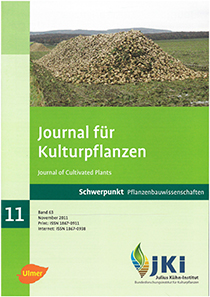The level of N<sub>2</sub>-fixation of different genotypes of winter pea in comparison to spring pea in pure and mixed stands
DOI:
https://doi.org/10.5073/JfK.2011.11.02Keywords:
Difference method, grain legume, mixture, N uptake, inorganic NAbstract
In contrast to the common spring pea (SP), little is known about the capacity of winter peas (WP) for symbiotic N2 fixation in pure and mixed stands. Therefore, seven WP genotypes and one semi-leafless SP in pure stands and two mixtures with cereals (25% (Mix1) or 50% (Mix2) of the pea pure stand sowing density) were examined in field experiments on two sites. The amount of fixed N2 at flowering and at mature harvest was assessed applying the extended total-N-difference method. At flowering and at grain harvest the N2 fixation for the five frost-resistant WP genotypes (52 and 85 kg ha–1, respectively) was generally higher than for SP (17 and 42 kg ha–1, respectively). This was traced back to the earlier N2 fixation of WP and a usually higher above-ground biomass (144 and 75 kg ha–1, respectively) and presumably higher below-ground biomass as compared with SP. Furthermore, average inorganic N in soil at mature harvest in pure stands was higher under WP (69 kg ha–1) than under SP (36 kg ha–1), while for any other treatment similar values on a lower level were estimated. Results show that WP may better contribute to the N supply within crop rotations than SP.
Published
Issue
Section
License
The content of the journal is licensed under the Creative Commons Attribution 4.0 License. Any user is free to share and adapt (remix, transform, build upon) the content as long as the original publication is attributed (authors, title, year, journal, issue, pages).
The copyright of the published work remains with the authors. The authors grant the Journal of Cultivated Plants, the Julius Kühn-Institut and the OpenAgrar repository the non-exclusive right to distribute and exploit the work.







